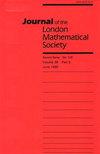Shift orbits for elementary representations of Kronecker quivers
IF 1
2区 数学
Q1 MATHEMATICS
Journal of the London Mathematical Society-Second Series
Pub Date : 2025-03-11
DOI:10.1112/jlms.70122
引用次数: 0
Abstract
Let . We denote by the wild -Kronecker quiver with arrows and consider the action of the group generated by and on the set of regular dimension vectors

克罗内克颤的初等表示的移位轨道
设r∈N小于3 $r \in \mathbb {N}_{\geqslant 3}$。我们用Kr $K_r$表示野r $r$ -Kronecker箭带r $r$箭γ i:1 × 2 $\gamma _i \colon 1 \longrightarrow 2$,并考虑G × r集团的行动) $G_r \subseteq \operatorname{Aut}(\mathbb {Z}^2)$由δ生成:z2, (x)Y)∑(Y, x) $\delta \colon \mathbb {Z}^2 \longrightarrow \mathbb {Z}^2, (x,y) \mapsto (y,x)$和σ r:z2, (x)Y)∑(r x−Y, x) $\sigma _{r} \colon \mathbb {Z}^2 \longrightarrow \mathbb {Z}^2, (x,y) \mapsto (rx-y,x)$在正则维向量集合上
本文章由计算机程序翻译,如有差异,请以英文原文为准。
求助全文
约1分钟内获得全文
求助全文
来源期刊
CiteScore
1.90
自引率
0.00%
发文量
186
审稿时长
6-12 weeks
期刊介绍:
The Journal of the London Mathematical Society has been publishing leading research in a broad range of mathematical subject areas since 1926. The Journal welcomes papers on subjects of general interest that represent a significant advance in mathematical knowledge, as well as submissions that are deemed to stimulate new interest and research activity.

 求助内容:
求助内容: 应助结果提醒方式:
应助结果提醒方式:


